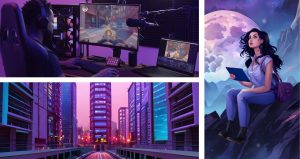Amid explosive interest in generative AI, the auto industry is racing to embrace the power of AI across a range of critical activities, from vehicle design, engineering and manufacturing, to marketing and sales.
The adoption of generative AI — along with the growing importance of software-defined computing — will continue to transform the automotive market in 2024.
NVIDIA today announced that Li Auto, a pioneer in extended-range electric vehicles (EVs), has selected the NVIDIA DRIVE Thor centralized car computer to power its next-generation fleets. Also, EV makers GWM (Great Wall Motor), ZEEKR and Xiaomi have adopted the NVIDIA DRIVE Orin platform to power their intelligent automated-driving systems.
In addition, a powerful lineup of technology is on display from NVIDIA’s automotive partners on the CES trade show floor in Las Vegas.
Mercedes-Benz is kicking off CES with a press conference to announce a range of exciting software-driven features and the latest developments in the Mercedes-Benz MB.OS story, each one showcased in a range of cars, including the Concept CLA Class, which is using NVIDIA DRIVE Orin for the automated driving domain. Mercedes-Benz is also using digital twins for production with help from NVIDIA Omniverse, a platform for developing applications to design, collaborate, plan and operate manufacturing and assembly facilities. (West Hall – 4941)
Luminar will host a fireside chat with NVIDIA on Jan. 9 at 2 p.m. PT to discuss the state of the art of sensor processing and ongoing collaborations between the companies. In addition, Luminar will showcase the work it’s doing with NVIDIA partners Volvo Cars, Polestar, Plus and Kodiak. (West Hall – 5917 and West Plaza – WP10)
Ansys is demonstrating how it leverages NVIDIA Omniverse to accelerate autonomous vehicle development. Ansys AVxcelerate Sensors will be accessible within NVIDIA DRIVE Sim. (West Hall – 6500)
Cerence is introducing CaLLM, an automotive-specific large language model that serves as the foundation for the company’s next-gen in-car computing platform, running on NVIDIA DRIVE. (West Hall – 6627)
Cipia is showcasing its embedded software version of Cabin Sense, which includes both driver and occupancy monitoring and is expected to go into serial production this year. NVIDIA DRIVE is the first platform on which Cabin Sense will run commercially. (North Hall – 11022)
Kodiak is exhibiting an autonomous truck, which relies on NVIDIA GPUs for high-performance compute to process the enormous quantities of data it collects from its cameras, radar and lidar sensors. (West Plaza – WP10, with Luminar)
Lenovo is displaying its vehicle computing roadmap, featuring new products based on NVIDIA DRIVE Thor, including: Lenovo XH1, a central compute unit for advanced driver-assistance systems and smart cockpit; Lenovo AH1, a level 2++ ADAS domain controller unit; and Lenovo AD1, a level 4 autonomous driving domain controller unit. (Estiatorio Milos, Venetian Hotel)
Pebble, a recreational vehicle startup, is presenting its flagship product Pebble Flow, the electric semi-autonomous travel trailer powered by NVIDIA DRIVE Orin, with production starting before the end of 2024. (West Hall – 7023)
Polestar is showcasing Polestar 3, which is powered by the NVIDIA DRIVE Orin central core computer. (West Hall – 5917 with Luminar and Central Plaza – CP1 with Google)
Zoox is showcasing the latest generation of its purpose-built robotaxi, which leverages NVIDIA technology, and is offering CES attendees the opportunity to join its early-bird waitlist for its autonomous ride-hailing service. (West Hall – 7228)
Explore to Win
Visit select NVIDIA partner booths for a chance to win GTC 2024 conference passes with hotel accommodations.
Event Lineup
Check out NVIDIA’s CES event page for a summary of all of the company’s automotive-related events. Learn about NVIDIA’s other announcements at CES by viewing the company’s special address on demand.












